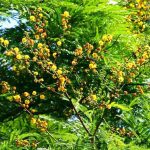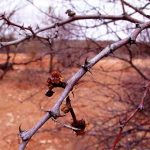TREE LIFE
August 1986
MASHONALAND CALENDAR
Saturday August 2nd : Botanic Garden Walk. Meet at the Car Park at 1045 for 1100 hours.
Sunday August 3rd : Usasa Farm, Chegutu. Tom and Norah Brierley’s lot past the Chien d’Or kennels. For details please phone Ann Bianchi, Chegutu 73012.
Sunday August 17th : Makumbi Mission, Domboshawa. Makumbi Mission is 100 acres right in the middle of tribal trust lands. Lovely scenery, enormous rock kopjes which are well wooded but naturally, being tribal trust, chopping has occurred. At the mission there is a primary and a secondary school, a T.B. Hospital, a Mission hospital, church and all the maze of buildings. Molly and Fr. Ross have done a recce and found a really nice spot. Bus booked and will leave Monomatapa Car Park at 0900hours. Fare $7.50.
Saturday and Sunday 23rd to 24th August : Centenary. A small group of us are planning to spend this weekend investigating the vegetation north of Centenary. Anyone wishing to join us for either of the days will be most welcome. It is a 2 hour drive and we would meet at about 1000hours. For details please phone Meg Coates Palgrave, 84419.
MATABELELAND NOTES
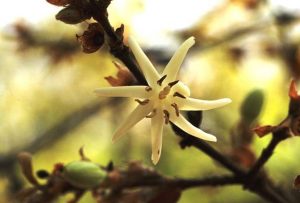
Sericantha andongensis. Photo: Bart Wursten. Source: Flora of Zimbabwe
In Sunday July 6th we went to Steadfast Park, Boys Brigade, in the Matopos, but not very far in. We had an excellent outing ad identified some 80 species I a short morning. Of the four Acacias species seen, the most interesting was Acacia mellifera, new to most o us, and especially noteworthy because of its larger leaflets and for being the exception to the rule that hooked spines have flowers in spikes. We hope to verify this in September or October. Aloe excelsa was flowering vigorously on the kopjes. We also saw Berchemia zeyheri, Brachylaena rotundata, Canthium lividiu, Carissa edulis and C.bispinosa alongside Catha edulis, Combretum apiculatum with very small leaves, Commiphora marlothii, Cussonia natalensis, Diospyros lycioides, Diplorynchus conldylocarpon on top of a kopje with unusually large flat leaves, Ehretia rigida, Erythrina latissima with big roots penetrating the rocks, Euphorbia matabelensis which caused some controversy until one saw the branchlets most notably in whorls of three, Ficus glumosa, F.ingens, F.natalensis, F.thonningii, Ficus salicifolia in fruit, Grewia flava, Kirkia acuminata, Maytenus heterophylla with tiny leaves, presumably subspecies puberula, which is confined to the Matopos area, Mimusops zeyheri, Osyris lanceolata, Pavetta gardeniifolia, Pavetta eylesii and P.schumanniana, Pterolobium stellatum, Rhoicissus tridentata, also Cissus cornifolia, three Rhus, Rhus lancea, Rhus leptodictya and Rhus pyroides which was most attractive as the leaves dried off, Schrebera alata, Securidaca longepedunculata, the violet tree, Sericantha andongensis, four Strychnos, S.cocculoides, Strychnos madagascariensis, Strychnos matopensis and Strychnos spinosa, Tarchonanthus camphorates, Tetradenia brevispicata, Turraea obtusifolia, Ximenia caffra, Zanthoxylum capensis.
-C.Sykes
CHEGUTU NOTES – JULY 1986

Rhus quartiniana. Photo: Bart Wursten. Source: Flora of Zimbabwe
Our July meeting was held on the banks of the Biri river, upstream from our June meeting on Chikanga, and the terrain was rather different, this time it was gentler, flatter farmland and a satisfying full weir on Carsky farm, belonging to Mike and Angela Campbell. Riverine species first caught our eyes, with Rhus quartiniana in typical fresh green foliage, trifoliate but not as noticeably scented as we expect the Rhus group to be when crushed, and then was it Myrica serrata or Salix subserrata to puzzle us – we did see the white lenticels on the young branches and noted the marked yellowish look of many leaves, but again did not notice that they were aromatic – but still decided our first choice was right. Nearby was Pappea capensis and Pteleopsis anisoptera reminded us of our warmer climate, the latter tree again easy to identify from recent sightings both on Chikanga and Brunswick, and from its neat axillary leaf buds. Albizia amara with fine feathery bi-compound leaves and no thorns, stood near to an Acacia Karroo with leaflets almost exactly the size of the drawings in our “Common Trees of the Central Watershed Woodlands of Zimbabwe” and severe large white spines, dark tipped and the occasional old pod on each tree to show us clearly the differences between Albizia and Acacia. A large Burkea africana and Pterocarpus rotundifolius graced a neighboring anthill, but with some hanging branches to let the new members of our group look at their leaves. Two Ochna species almost had some of us puzzled, it is always a great pleasure for me when the newer members work a puzzle out before I do, and so it was this time, Richard found the peeling bark and less noticeably serrated edges of Ochna pulchra and then Brian and Graham found O.schweinfurthiana barely two meters away, all small saplings, so unlikely to be flowering for some time yet. Flacourtia indica nad Friedsodelsia obovata both had ripening fruit on for those who had not yet tasted hem, or brought back memories of Hartley school days to others. And Mike added to our knowledge of Flacourtia, a keen member of the Game and Hunting preservation brotherhood, he told us that he has seen that it is browsed with relish by game animals, and later when we met up with Combretum zeyheri, in fruit, he said that is also a favourite kudu browse. In the Chegutu district we have come to expect to see a fair selection of Combretums, easy for beginners to learn, with their distinctive 4 winged fruits, and yes, we did see them, scrubby C.apiculatum where in the past wood cutters had been busy, large C.collinum leaning over the water, smaller C.molle with leaves turning maroon red gold, but still sufficiently velvety for the reason for the name to be explicable; C.fragrens also turning into winter aroo and purple grey in typical whorls of three; C.hereroense, into winter maroon and purple grey in typical whorls of three; C.hereroense, grey green leaved leaning over the water with branches well laden with chocolate brown fruits; and C.zeyheri, its fruits still greenish in places, but enough turning the straw yellow that is so lovely. Also at the water’s edge, a large Kigelia africana with long pendulous racemes of flower buds – one or two open for us to see the glorious colour – have you noticed that overnight any flowers that fall off in the day seem to be eaten up with relish presumably by buck? At our feet there, a snake slithered off in fright to swim away downstream, Mike thought it a Mamba; later on a squirrel disappeared up another tree, and a mongoose, slender?, dashed away from us, while higher upstream a Pied Kingfisher learnt to ignore us, and Grey Louries scolded us from across the stream. Strychnos spinosa, bauble bedecked in gay green fruit, and S.potatorum stood near enough to one another to provide interesting contrasts, but yet to illustrate the typical Strychnos venation in the leaves. Pseudolachnostylis maprouneifolia shed ripened fruits around a large anthill, well named Duiker berry from the footprints we often see around these trees at this time of year. And then another puzzle, a large twisted tree leaning right out over the water, with long strap like leaves, and a conspicuous being yellow on the underside of the midrib, the trunk having been fire damaged at some time, so that the bark was difficult to identify, we think it was Boscia salicifolia. Not far away were Faurea saligna, their narrow drooping leaves unmistakable with their pink tinged petioles, the odd leaf turned beautiful shades of red and orange. Zanha africana, with ball and claw growing tip to aid identification, Ziziphus mucronata with wait a bit paired thorns pointing in different directions, another game fodder tree, and some members remembered coffee being made from the fruits; Terminalia sericea also displaying change of season colours, and quite striking a Vernonia in full flower, the mauve colouring very pretty, and the leaves large, somewhat rounded and wavy, so we felt it must be V.colorata. By this time all sated with names and new things to learn, those who could stay, followed Mike for lunch to a lovely rocky area below the second weir, where rock formations and twisted and water worn Mimusops zeyheri and Croton gratissimus gave an aesthetically satisfying end to a lovely day. What need have we of possessions when we can share so much pleasure in the endlessly lovely and fascinating bush of this country? It was good to welcome Anne, to see Graham join us before he goes off to college in the UK. And to have a visitor from that country join us. Thank you to Mike and Angela for sharing one of their favourite walks with us all.
-Ann Bianchi
AYRSHIRE BRANCH OF THE TREE SOCIETY OF ZIMBABWE – GLEN-A-MEL
On 1st June we went down to Glyn-a-mel on the Manyame river; due West of Raffingora. Map reference Raffingora 1730A2 TS 165 145 in the vicinity of Chisanga hill. A crow would have flown 10km, our journey was quite 30km. Derek Henderson led the way along the Mhangura road crossing the Manyame at the Causeway on Allagrange, soon we turned off left, south, to Silverside and Chesdale. John Denver’s song comes to mind
“We didn’t know who e were
We didn’t know what we did
We were just on the road … just ridin’ on the road.”
On and on over the hill, dale and several rocky streams until there was no more road in a clearing overlooking the sparkling river and a weir under construction on Glyn-a-mel.
The riverside vegetation on sandy flats interspersed with rocks did not get much attention but we noticed willows and reeds called Phragmites mauritianus which are the raw material of sleeping mats. Large fruited bush willow, Combretum zeyheri, grew on the shelf above the alluvium. Its four winged fruit may be considered to represent the points of the compass.
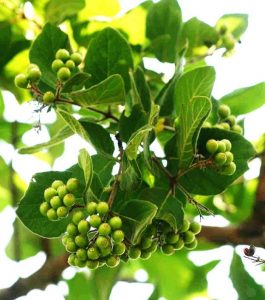
Crossopteryx febrifuga. Photo: Bart Wursten. Source: Flora of Zimbabwe
Moving to higher ground we slowly climbed a stony hillside. Derek, our geologist, said the rocks were greenstone schist, the weir is being made of this stone. The following plant species were identified:
Acacia goetzei; Albizia antunesiana; Brachystegia allenii, with grey green ‘loured’ leaflets; Bauhinia petersiana; Burkea africana; Combretum molle; C.fragrens; C.zeyheri; Crossopteryx febrifuga, known as crystal bark has pink wood which is made into kitchen spoons. Cabbage tree Cussonia arborea was shedding its leaves in spite of mild weather and late rains. Englerastrum sp. was that was that sticky red stemmed herb which bore tiny blue flowers. Euphorbia matabelensis called Murimbo by the Mashona, provides birdlime. Faurea saligna has Eucalyptus like leaves; Gardenia ternifolia is the lightening strike protector; the orange flowered succulent Kalanchoe lanceolata used as a lucky charm was unmolested, had we picked a part of this plant would it have spared us misfortune later that day?
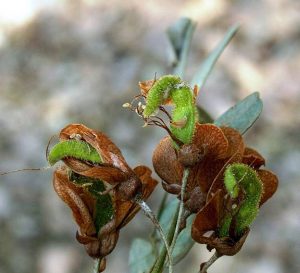
Ormocarpum kirkii. Photo: Mark Hyde. Source: Flora of Zimbabwe
Green caterpillar pods of Ormocarpum kirkii were shown to the little ones who accompanied us, Jennifer and Caroline Fernsby. Ozoroa reticulata; Pericopsis angolensis; Pleurostylis africana graced the slope with its dainty form but was not in fruit, a pity because they are like droplets of candle wax, each with a minute black dot half way down on one side, this is the remains of the style. Rubber tree was not needed to stick our vehicles together, mercifully they survived the indignities they suffered en route. Carrot tree called Steganotaenia araliacea prompted instructions on how it can be made into a pop gun. We gathered around a couple of pink jacarandas to see their pied bark, their only virtue at this time of year. Beside a small monkey orange Strychnos innocua grew the pot scrubber plant now named Xerophyta equisetiodes, like docked horsetails, which was crowned with an epiphytic orchid called Aerangium mystacidii, interesting because Xerophyta stems are shaped into orchid pots which are sold at gardening shops.
Now we have arrived at the end of the alphabet with Zanha africana and Zanthoxylum chaiybeum, ex Fagara. This specimen went to Harare for identification. It seems to me that the description does not fit, the leaves have neither a citrus smell nor pellucid dots, the dots are black. This sample is still recognizable for future study.
When we had nearly reached the summit of the hill, up ahead there was a patch of orange …blossom? … it moved. Phil Mugford’s hat. He had gone aloft map in hand to locate our position. To the East we face the tree clad range of hills on Zilawa and S.S.Ranch, this was big game country less than fifty years ago. Descending the hill, just before lunch, Moira Mugford fell and damaged her ankle. The deformity was alarming, we marveled at her bravery and cheerfulness whilst being carried down the treacherous slope to the car. We did not know what to do, so the first aid was minimal. We diagnosed dislocation which turned out to be three broken bones. Clothing and other items were brought to make her comfortable on the deck of the station wagon. Gill Henderson attended Moira Tutty on the journey to hospital. With heavy hearts we watched Phill Mugford drive away on that rough road to Raffingora and thence to Harare’s Avenues Clinic. It was not many days later that Tutty ran an extreme high temperature, malaria was suspected, but it was hepatitis. These misfortunes are particularly upsetting since Phill and Tutty are newcomers to our group. You are in our thoughts Tutty, we hope the convalescence will not be too tedious, we miss seeing you around. We send our greetings and good wishes for your complete recovery.
Someone at the Avenues Clinic asked Gill about her friend’s accident. “What were you doing at the time?” Gill answered, “Oh, we were out with the Tree Society.” “Oh that’s nice, the questioner paused for thought, did she fall out of a tree then?”[
Lunch beside a stream on the Chesdale/Silverside road cheered us up. Around us was a species richness totally unexpected, how we wished for the Harare fundis.
A visit to the Herbarium added at least six names to the list of plants we found in a very small area of narrow riverine fringe. Here is another string of Latin names to encourage the experts to visit this spot and to recommend that you travel in vehicles which have ample clearance.
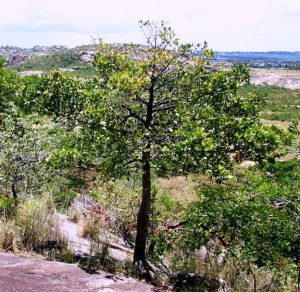
Garcinia huillensis. Photo; Bart Wursten. Source: Flora of Zimbabwe
We saw the following species : Albizia amara; Bequaertiodendron magalismontanum; Canthium lactescens was the tree with wide spreading branches bearing wide, large simple leaves; Celtis africana, pale trunked and stately; Erythroxylum emarginatum with small glossy leaves borne on small branches likened to lizard’s feet; fruits of Monkey’s fingers, Friesodielsia obovata were tasted, these were appreciated by tree walkers at Rukomechi when the supply of drinking water was nearly finished. The rigid forms of Garcinia huillensis was conspicuous and could inspire a wood carver or sculptor. Jasminum fluminense had no flowers; Kigelia was a sapling with toothed edges to its leaves unrecognized by us Nuxia oppositifolia; Peltophorum africanum; Pittosporum viridiflorum grew close to the road as did Quinine tree, Rauvolfia caffra and Vernonia ampla. We are certain that closer inspection would have revealed many more species.
The second name in the previous paragraph is stem fruit. It is an example of cauliflory as is Cacao tree, the source of chocolate, and some well known indigenous fig trees. This device is an adaptation to environment by trees which grow in deep shade. Cauliflory is the formation of flower buds on leafless woody stems. This quaint phenomenon may ensure that the flowers are pollinated by shade loving creatures, since the blooms cannot be displayed in full sunshine where pollinating insects are plentiful. A more satisfactory explanation is that these buds result from an accumulation of stored foods in the trunks and branches of evergreen trees, this happens when conditions in the tree are conducive to fruit bud production and the ratio of carbohydrates to mineral salts is high.
-Benedicta Graves
DARWENDALE DAM : 20TH JULY 1986
It is not often we have guests from beyond the border, so it was most refreshing to have Pat and Val Kleyn with us. Pat is currently chairman and Val the PRO for the Tree Society of South Africa. It was also a pleasure to head back to the dyke again, although this time further south than usual.
On the geological map the Great Dyke lies like a narrow scar across the country from Guruve, Sipolilo in the north to West Nicolson in the South. In section the Dyke resembles a trough of serpentine filled with pyroxenite. The pyroxenite is high in magnesia, this explains the day or two of diarrhea that may result from drinking dyke water, and iron oxide, this rust gives it a red colour. As it resists weathering the proxenite forms the range of hills that stretches northwards from Darwendale Village. Just before the village the bus crossed the eastern lip of the serpentine trough and immediately the vegetation changed to grassland with numerous rubber trees, Diplorhynchus condylocarpon. This is one species which can tolerate the high nickel and chrome toxicity in the serpentine soils. Other trees that tolerate the serpentine soils are Combretum molle and Acacia karroo. Before entering the village the soil changes to pyroxanite and then the road turns south towards the Manyame, Hunyani, River cutting. Darwendale wall dams the Manyame by blocking its entrance to the Great Dyke. Here the structure of the Dyke is not simple as there are a number of serpentine troughs inside one another and each separated by pyroxenite.
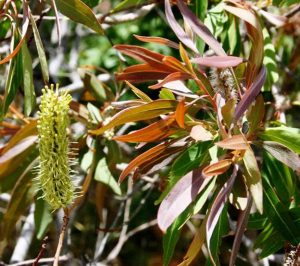
Faurea saligna. Photo: Bart Wursten. Source: Flora of Zimbabwe
We debussed alongside the old bridge and set out to explore the riverine vegetation. Prof Wild concluded that riverine trees were least affected by the mineral toxicity, although the vegetation along the Manyami is certainly very different from that which grows along the streams that cross the Dyke further north. There the banks are lined with clusters of Phoenix and Maesa, Rapanea and Vangueria randii grow in the thick shade under Bequertiodendron. Walking along the Manyame we saw flood debris high in the riverine trees and this may help explain the sparer vegetation here. Nevertheless the woodland was well developed and we found fine specimens of many species we only seldom see. The thick Mimusops zeyheri were covered in green fruit and as they grew alongside Bequertiodendron we were able to examine the vegetative features of the SAPOTACEAE, the family to which these species belong. Both trees show looping branch growth, furry tips and a silky sap. Earlier this year when the spillway gates had opened these trees were inundated with rushing water. The Salix subserrata took the greatest hammering and survived it well. This is when the narrow streamlines leaves are an advantage. The plants are also multi trunked and well anchored. Another flood survivor if Rhus quartiniana var. quartiniena, a species with resinous leaves that everyone was able to smell. Despite much effort we could not elicit a cyanide smell from Olax dissitiflora, the drooping leaves were no longer green but had turned reddish brown. Other trees with “autumnal” colours were the dark maroon Flacourtia indica and fiery red Faurea saligna. It is still too early for the bright reds of Pseudolachnostylis.
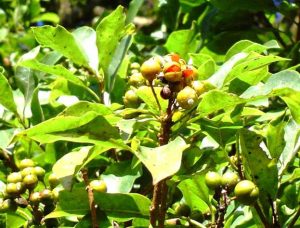
Pittosporum viridiflorum. Photo: Bart Wursten. Source: Flora of Zimbabwe
The Pittosporum viridiflorum were ripe with their orange fruit that splits into two bikini cups filled with vivid red, very sticky seeds. Further up the sides of the river bank tall Brachystegia glaucescens dominate the woodland with Hexalobus monopetalus, Turrea nilotica, Bridelia cathartica and Garcinia buchananii in the under storey. I was somewhat confused by the Margaritaria discoides and mistook it for Securinega virosa. The latter has much thinner leaves and Margaritaria has a leaf margin that isrolled under, in fact the two are not very similar at all. We were impressed by the size of Rhoicissus revoilii and were pleased to see both Dalbergia melanoxlon and D.nitidula. The Olax was not the only species with drooping leaves, there was also Pteurostylia africana and Meg’s group found Cassine matabelica. The Pleurostylia was adorned with oval green berries and the C.matabelica looked very much like Catha edulis. We failed to find any Catha, but we were able to compare the opposite leaves of C.matabelica with the alternate leaves of C.aethiopica. The list of highlights goes on and on, Mundulea sericea, Crotalaria palidicaulis with fat pods, Diospyros natalensis, Carissa edulis, Maytenus heterophylla, as well as M.senegalensis, Tricalysia and Veronia colorata. Apparently Olea and Boscia saliciflia were also found.
The large party spread out along the old bridge and on the sandy beach for lunch, listening to the gentle sound of running water and warming up in shafts of sunlight. We had seen little evidence of the toxic serpentine soils although in retrospect I am now certain we crossed at least two bands of serpentine in our afternoon walk from the bridge up to the dam wall itself. This was most rewarding, the path open and surrounding trees were park like in their arrangement. The first band of serpentine had Diplorynchus on it and was not very well defined. The second band we entered just before reaching the wall and here the species diversity was low, the tree layer consisted almost entirely of tall but scattered Acacia karroo. Besides these strips most of the walk was on pyroxenite with Pterocarpus angolensis, fine specimens of Ormocarpum kirkii, Bauhinia petersiana, Diospyros kirkii and Euclea natalensis, the latter in large green fruit. We identified Erythroxlum emarginatum by the crackle of its shiny leaf and were pleasd to find a cluster of Aloe excela about to come into flower. Many of the Ximenia americana had a strange growth with stunted leaves and twisted branching, the flowers helped to confirm the identification as these re-grouped into bunches on the same stalk, in contrast to X.caffra, where the flowers hang singly. We found X.caffra but not in flower. We were pleased to show our visitors the ET – fingers on Lannea discolor – such a rewarding feature at this time of the year. We found both Vangueria infausta and Vangueriopsis lanciflora, and yes they are very different, I usually get muddled with the names and not the plants. “Vangueria is hairier” and Vangueriopsis has harder leaves which are often ornamental by deformed growth and also have a bark which rubs with a red powder. We did all se the Acacia gerrardii and after our revision, and revision of it in the Botanic Gardens, we should really have no trouble with it, although we still do!. Tom’s clue of red flecks on the young branches worked well, as did the distinctive leaf arrangement were the leaves are clustered around the unbranched shoots.
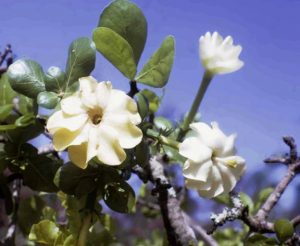
Gardenia ternifolia. Photo: Bart Wursten. Source: Flora of Zimbabwe
Most of the way we were guided by the sound of water spewing from the sluice gate, as well as an occasional view of the dam wall between the trees. Down below us the blue river twisted over the alternating bands of pyronite and softer serpentine. Just before the turn off to the wall we found a large Gardenia ternifolia in flower and fruit. This is the first time I have noticed that the flowers of the G.ternifolia are half the size of those on G.volkensii. The fruits are smooth and not ribbed and the bark rubs with a fine powder. Before the afternoon tea we walked the length of the dam wall, admiring the many aloes in flower, including a peninsular of Aloe ortholopha. This species, with its characteristic horizontal spikes is endemic to the toxic serpentine soils although this dense clump was probably planted, possibly rescued from the rising waters of the dam.
The bus returned via the Bulawayo road. We are all used to seeing busses unloaded at roadblocks and for the first time Tree Society had the pleasure of showing the traffic police our empty lunch containers and filled nappy bags. We obviously passed the test and re-boarded the bus once again. All in all a most rewarding day, our thanks to Mr. Makombe of the Department of National Parks and Wildlife Management who waived the entrance fee to the Dam area itself.
-Kim ST.J.Damstra
MWENGE DAM, MAY 1986 – CONTINUED FROM TREE LIFE 76
I never completed the write up to Mwenge Dam but now two months later, the impressions are just as fresh as they were then, a most exciting day.
Beyond the Antidesma we bent our way beneath the low canopy. It was only when we came across a tall pod mahogany, Afzelia quanzensis, that l realized there was an upper canopy of large trees. This old, twisted specimen carried the odd mahogany pod as a clue to its identification. This dry season we have seen a number of leafless specimens of Afzelia and all with a very similar shape. Remember the specimens on the hillside opposite Trevor Cox‘s house. In each case the stout bole is straight for about 3 – 4 meters and then it divides into a number of beefy limbs, each one spreading outwards in a contorted and twisted way.
A Psorospermum in the under storey confused us all for a while, its large leaves and lush growth resulted from the shady conditions. Usually the leaves are smaller but then the plant is generally found in the dappled shade or full sunlight of the open woodland. The distinctive black dots, glands, along the leaf margin and on the under side of the leaf helped confirm our diagnosis. I m not sure whether I have discussed these in the newsletter, but I would be most interested in any information on grazing of Psorospermum by game or cattle. The interest lies in their close relationship with Hypericum, they both belong to the CLUSIACEAE. Those specimens of Hypericum that also have these black dots, for example both of our indigenous species, are reputed to cause photosensitization in cattle. A few species of Hypericum, such as the exotic St. John’s wort most commonly cultivated in local gardens, lack these glands and are not toxic to cattle. Photosensitization is an interesting phenomenon and can result from cattle eating a number of plants. In Hypericum it is caused by a chemical secreted by these black glands. We all know that plants trap the energy in sunlight and then use it to build up sugars and starch. The energy trapped by chlorophyll is extracted from the leaves and put in a test-tube where it cannot convert the sun’s energy into sugar, then the energy it absorbs will be released as light energy so that the solution is fluorescent. The large organic molecule produced by the glands of Hypericum also absorbs light energy but never uses this energy to make sugars. Instead it always radiates this energy outwards. When cattle eat those species of Hypericum that have these glands this chemical is absorbed by the intestine and travels in the blood stream to the skin where it is deposited. If the skin is exposed to sunlight then the absorption and re-radiation of the light energy is very damaging to the sensitive cells in the skin, leading to severe burns. The pigment is also deposited in the eye and so the animal becomes very sensitive to bright lights. Where the skin is black in colour the dark pigment, melanin, absorbs the light energy and so protects the skin from burning, so in a black and white cow the burning only occurs on the white patches, or the more exposed areas of the face. Under these conditions the cow needs to be kept in subdued light and eventually the effect wears off as the chemical is either broken down or removed. Although photosensitization is well documented from Hypericum it would not be surprising to find that Psorospermum is equally toxic, although neither of these plants are preferred browse.
The next large specimen was a Parinari of magnificent girth. In the shade under this tree we found Strychnos innocua with its powdery bark and numerous Ehretia amoena with their rough leaves so characteristic of the BORAGINACEAE. A little further along and we headed left off the path towards a large Kigelia africana, hanging with the large sausage fruit. This tree was the first indication that we were closer to the river, an impression that was confirmed by finding one of the most striking specimens of Combretum erythrophyllum I have seen for a long time. These trees are often undermined by floodwaters and yet survive the most severe uprooting. Many specimens, like this one, lie horizontally with their roots party exposed and then they send up strong vertical shoots from the old trunk. All of these features make them excellent living bridges for crossing streams. The entire trunk of this specimen was thoroughly scarred with the distinctive “cat’s claw” marks.
We crossed the first of many fences for the day and headed for the sound of running water, finding Salix subserrata, Myrica serrata and Rhus quartiniana. By this time the group was spread out and Pat and I were left behind yet again, aware that we were rushing past exciting trees in order to catch up we climbed back through the fence and onto the broad path once again. While searching for pods beneath a tall spreading Acacia I was alarmed by suddenly coming face to face with a friendly cow. The search was abandoned and Meg’s verdict of A.sieberiana was accepted. On a termite mound nearby we found a grove of the largest Dalbergia melanoxylon I have ever seen. The boles were each a good arms’ length in circumference. Amid mumbles about beer time and talk of rumbling stomachs we pressed on yet again to find Jatropha curcas, the physic nut. This is the first time I have seen it in the wild, although it is reputed to have escaped in a number of areas. Bob Drummond showed us this tree in the commercial section of the Botanic Gardens. The plant belongs to the EUPHORBIACEAE and the seeds are used to make candles and soap they are also used as a purgative, but I would not recommend them.
Downstream we found an Ekbergia capensis turning red, another unusual find around Harare. Later in the day we noticed an even larger tree alongside the Car Park. The front of the party followed their stomachs back to the bus, crossing yet another three fences. The path was lined with many magnificent specimens, but we pressed on.
After lunch the bus drove to a nearby kopje which we climbed to get a superb view of the dam itself. Here we were able to reinforce the impressions of Strychnos innocua and found Friesodielsia obovata with its sausage shaped red fruit. These make a refreshing snack, particularly in the Zambezi Valley. Amongst the rocks we noted the truncated leaves of Ficus natalensis and found a Commiphora mollis decorated with balls of green fruit. I must confess to having stopped botanizing and simply enjoyed the rocks and the company, the view and the sunshine. We must return to Mwenge sometime, there was too much to absorb in just one visit.
-Kim ST.J.Damstra
ROOTNOTE : Meg has kindly arranged Tree Society lapel badges. These study badges have the Tree Society’s baobab emblem nearly printed on the face and are available from Meg at a cost of only $2.50. May I recommend that you all get one!
KIM DAMSTRA CHAIRMAN


